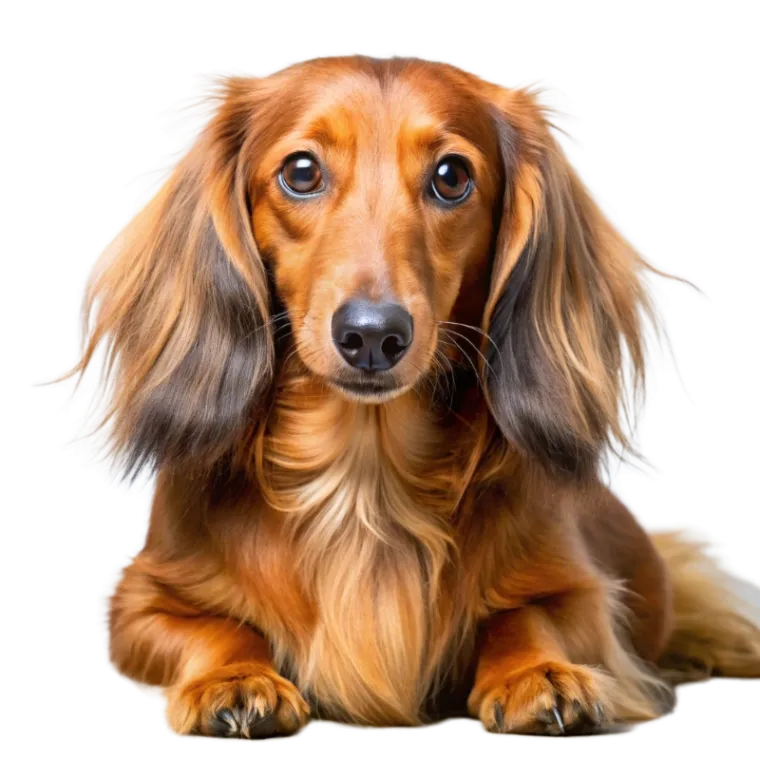Long-Haired Dachshund





 Find Long-Haired Dachshund Breeders Near You
Find Long-Haired Dachshund Breeders Near You
Connect with certified breeders who have Long-Haired Dachshund puppies available.
Find Long-Haired Dachshund BreedersGet to Know Long-Haired Dachshunds
- Bred for Hunting: Long-Haired Dachshunds were originally bred in Germany to hunt badgers, rabbits, and other burrowing animals. Their name "Dachshund" literally means "badger dog" in German. The long, flowing coat of the Long-Haired variety is believed to have been developed by crossing smooth-coated Dachshunds with spaniels to help protect them from cold and rough terrain while hunting.
- Distinctive Coat: The most distinguishing feature of the Long-Haired Dachshund is its beautiful, silky coat. Unlike their smooth and wire-haired counterparts, Long-Haired Dachshunds have a coat that can be wavy or straight, with feathering on the ears, chest, legs, and tail. Their luxurious coat requires regular grooming to prevent matting and to keep it looking its best.
- Gentle and Calm Temperament: Compared to the other Dachshund varieties, Long-Haired Dachshunds tend to have a calmer and more laid-back temperament. This is often attributed to the influence of spaniels in their breeding. They are still spirited and playful, but they may be slightly more affectionate and less stubborn than their smooth and wire-haired relatives.
- Loyal and Protective: Like all Dachshunds, Long-Haired Dachshunds are fiercely loyal to their families and can be very protective. Despite their small size, they have a strong, bold personality and are known to be excellent watchdogs. They are often wary of strangers and can be vocal when they sense something out of the ordinary.
- Versatile and Adaptable: Long-Haired Dachshunds are versatile dogs that adapt well to various living situations. They can thrive in both apartments and houses, as long as they get enough exercise and mental stimulation. They enjoy activities like walking, playing fetch, and even participating in dog sports like agility and tracking, which cater to their hunting instincts.
Breed History
The Long-Haired Dachshund is a variation of the standard Dachshund breed, originally from Germany. The breed was developed in the 17th century to hunt badgers and other burrowing animals. The long-haired variety was bred to withstand harsh weather conditions and protect against thorns and briars while hunting. Over time, the Dachshund’s affectionate nature and charm led to its popularity as a family companion. Today, Long-Haired Dachshunds are admired for their unique coat and friendly disposition, blending the classic hunting instinct with a loving, adaptable temperament.
Personality and Behaviour
- Confident and Curious: Long-Haired Dachshunds are confident and curious dogs. They are not easily intimidated and often approach new situations with a sense of bravery. Their hunting heritage makes them naturally inquisitive, always exploring their surroundings. This curiosity can sometimes translate into stubbornness, so early socialization and training are essential to manage their inquisitive nature.
- Affectionate and Loyal: Dachshunds, including the long-haired variety, are deeply loyal and form strong bonds with their owners. They enjoy spending time with their families, following them from room to room, and snuggling up for a cozy nap. This loyal nature makes them excellent companions, particularly for families with older children or singles who can provide plenty of attention and interaction.
- Intelligent and Alert: Long-Haired Dachshunds are intelligent and alert dogs. They have keen senses and make excellent watchdogs. Their alert nature, combined with their ability to learn quickly, makes them well-suited to training in obedience and tricks. However, their independent streak requires patience and consistency in training.
Care
- Exercise: Long-Haired Dachshunds have moderate exercise needs. They enjoy short, daily walks and are happy to play in a secure yard or indoors. They should not be over-exercised, particularly on hard surfaces, as their long backs are prone to injury. Gentle play, like fetch or hide-and-seek, and mental stimulation through puzzle toys are ideal for keeping them happy and healthy.
- Grooming: The Long-Haired Dachshund has a long, silky coat that requires regular grooming to prevent tangles and mats. Daily brushing is recommended to keep their coat looking its best and to reduce shedding. Regular baths are necessary, but not too frequent, to maintain a healthy coat. Other grooming tasks include regular nail trimming, ear cleaning, and dental care. Due to their long backs, care must be taken during grooming to avoid injuries or discomfort.
- Training and Socialization: Training a Long-Haired Dachshund requires patience and a positive reinforcement approach. They are intelligent and learn quickly, but their independent nature can make them a bit stubborn at times. Early socialization is key to preventing behavioral issues such as aggression or shyness. They should be exposed to different people, environments, and other animals to help them develop confidence and good manners.
Long-Haired Dachshund Summary
What to ask your breeder?
Here’s a short summary of what you should be asking your breeder:
Long-Haired Dachshund Health Testing
| Screening | Considerations |
|---|---|
| ACVO Eye Exam | Eye Examination by a boarded ACVO Ophthalmologist. Dogs can be evaluated when their eyes are open. Males and females should be evaluated within 2 years prior to breeding. |
| Patellar Luxation | OFA Patella Evaluation at 12 months of age or older. It is recommended that dogs be periodically reevaluated, as some luxations will not be evident until later in life. Patients that are evaluated and found to have patella luxation should be reevaluated by a Diplomat of the College of Veterinary Surgeons for confirmation. |
| Cardiac | (Optional but recommended) Basic Cardiac Exam Minimum age for OFA/CHIC certification is 12 months, however earlier examinations are encouraged as most of congenital diseases can be detected at a much earlier age. Adult males and females should be evaluated again within 2 years prior to breeding. |
How Much Does It Cost to Own a Long-Haired Dachshund Per Year?
Determining the cost of owning a Long-Haired Dachshund is essential for responsible dog ownership. Use our calculator to estimate expenses, including food, grooming, veterinary care, and more.
The Ultimate Dog Cost Calculator
 Calculate Now
Calculate Now

